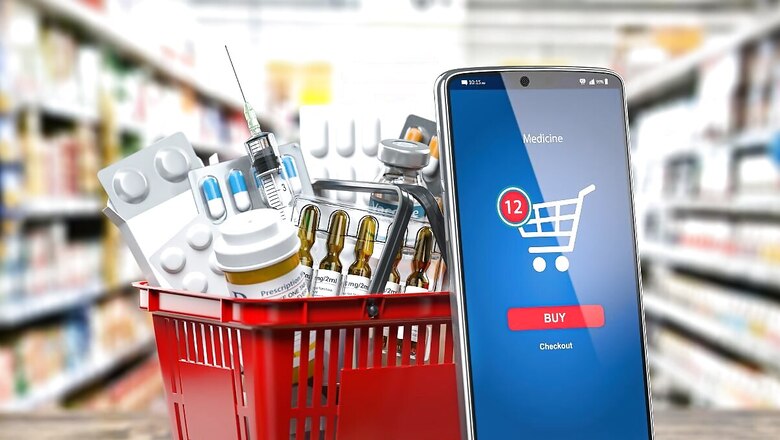
views
Even though e-pharmacy sales constitute only 3 per cent of pharmaceutical sales in India, they have faced severe opposition from the lobby of retail pharmacists — All India Organization of Chemists and Druggists (AIOCD).
The DCGI organised a consultation meeting to discuss the Delhi High Court order passed on online sale of medicines, giving time to the government to either frame rules or take action against e-pharmacies.
The drug regulator had informed the court that it was thinking of holding fresh stakeholder consultations related to the matter and hence, the meeting. The matter is listed for hearing on August 28.
The meeting on Thursday was attended by representatives from the chemists’ body AIOCD, Pharmacy Council of India and online pharmacy platforms, including Tata 1 MG, PharmEasy, Netmeds, Practo, and others.
Inside details of the meeting
In March, a top government official said the group of ministers (GoM) is in favour of closure of e-pharmacies as they did not propose the idea in the present shape — hinting at the government’s U-turn on legalising the industry.
Since then, the industry has been making unsuccessful attempts to meet with officials at the health ministry.
However, three sources who attended the meeting on August 24 indicated that the government’s stance, which had previously been unfavourable to e-pharmacies, appeared to be ‘neutral’ now. “At least, they are discussing the issue,” the first source said.
An e-pharmacy industry representative, who was also present at the meeting, stated that they align with the government’s perspective when it comes to asserting that there is no distinction in the operations or order fulfilment between online and offline pharmacy businesses.
“Dispensation has to happen from a brick-and-mortar pharmacy only so there is no difference in our or their business mechanism,” he said. “Till now, it is only the front-end part that is under discussion which is about the sourcing of orders.”
Now, the DCGI is likely to seek more time in the next hearing as stakeholder consultations are still going on.
The main discussions revolved around data privacy, inventory versus marketplace models, licenses and liabilities (that should be considered for platforms) and assurance of doctors and pharmacists in the chain among other issues.
“Everyone basically agreed that there should be a dispensation from a licensed pharmacy by a pharmacist, and upon a doctor’s prescription in all cases, online or offline,” the third source said.
DCGI has also sought suggestions from the e-pharmacy industry on what they could do to “ensure better consumer grievance management, especially around medicine expiry, returns and availability of pharmacists”.
The industry is likely to submit its recommendations by this week.
Govt plans to create one policy, bring e-prescriptions
The government is trying to figure out a way under which regulations are channel agnostic and should be applicable both online and offline.
Reason: 97 per cent of the pharmacy industry in India is dominated by brick-and-mortar or offline chemists whereas the online sales of drugs or e-pharmacies constitute just 3 per cent of the market.
A government official in the Ministry of Health and Family Welfare told News18 that “the idea is to create one set of policies that can apply on both platforms instead of making two separate policies for online and offline pharmacies”.
“In fact, we want to create a system for e-prescriptions and are already studying several models for the same,” he said, without divulging more details which are at premature stages of discussion.
Why do we need e-pharmacies?
According to a study published in 2020 titled “E-pharmacies in India: Can they improve the pharmaceutical service delivery?”, medicine costs in India account for about 70 per cent of all healthcare costs.
It said the availability of medicines remains sub-optimal in the public sector, forcing the majority to depend on the more expensive private sector.
“And to solve this public health crisis, India needs a far more efficient pharmacy sector,” said the study published in the Journal of Global Health, adding that “the rising chronic disease burden in urban India is also likely to expand the online pharmacy market, outdoing the retail counterparts”.
Another discussion paper presented at the Internet Governance Forum 2019 in Berlin listed the benefits of e-pharmacies or internet pharmacies. These include familiar benefits of e-commerce such as convenience and privacy, as well as price transparency, comparison shopping, and access to medicines when there are shortages locally.
Multiple studies have found that cost-related issues remain the most commonly stated motivation by consumers for seeking out Internet pharmacies.
Global demand & challenges in mid-low income countries
Undoubtedly, people do seek medicines online, akin to how they shop for various products on platforms like Amazon, Flipkart, Blinkit, and Zomato.
The data shows, globally, the demand for online pharmacies, is surging.
According to the Global Online Consumer Report by consultancy firm KPMG, for example, 20 per cent of respondents indicated that they had bought medicines and other healthcare products online.
The US National Center for Health Statistics estimated that approximately 47 lakh Americans rely on personal medicine importation, which includes internet pharmacies.
The region that presents the biggest knowledge gap is low and middle-income countries, said the paper authored by Aria Ilyad Ahmad, York University in Canada.
“While adoption of stringent restrictions on Internet pharmacies in some of these countries is partly responsible, this also reflects broader evidence gaps on health systems utilization and digital consumer behaviour.”
“Gaps in our understanding can pose public health and policy challenges. That is exacerbated in this case by significant access and affordability gaps coupled with vulnerabilities in physical and digital regulatory systems.”
Slow uptake not just in India
Divergent reception is not limited to India but extends to numerous other countries worldwide.
For instance: In the United States, efforts to regulate e-pharmacies involved limiting online sales permits exclusively to websites certified by the National Association of Boards of Pharmacy (NABP) and accredited through the Verified Internet Pharmacy Practice Sites (VIPPS) programme. Additionally, the US implemented more stringent regulations, including the blocking of credit card transactions for e-pharmacies lacking NABP/VIPPS certification.
Also, it’s not even a year since China introduced “Administrative Measures for Supervision of Internet Pharmacy” which opened the door wide for the operation of Internet pharmacy businesses in the country.
In December 2022, China permitted internet pharmacies to sell both non-prescription and prescription drugs whereas the controlled drugs are not within the scope.
Apart from US and China, many other countries such as Brazil, Mexico, Indonesia and Italy also allow e-pharmacies but there is a significant diversity across nation and its states in how they regulate pharmacies.
Regulate, not reject
E-pharmacy needs regulation and not prohibition. Considering that the country has been running one of the most crucial and ambitious projects for creating the digital backbone of the healthcare ecosystem — Prime Minister Narendra Modi’s flagship Ayushman Bharat Digital Health Mission (ABDM) — rejecting the concept of e-pharmacy would sound incongruous or hypocritical.
Digitisation of healthcare will not be complete without creating a solid, fool-proof mechanism for online sales of drugs.
Last year, the research conducted by Frost & Sullivan for the Chinese market for opening up the e-pharmacy market said: “The timing is particularly good as over half of the Chinese population are internet users and regularly shop online and China is experiencing a massive increase in demand for health care goods and services.”
Data shows that internet pharmacies account for over 30 per cent of the total retail sales in the US and 1.5 per cent in China.
Internet pharmacies account for 3 per cent of total retail sales in India — double that of China — despite the erratic regulations and unfavourable growth conditions. It shows that probably the demand in India is much higher than in China and hence, it’s time to regulate so that everyone plays by the rulebook.
Denying the demand and booming industry would end up creating a black market.


















Comments
0 comment